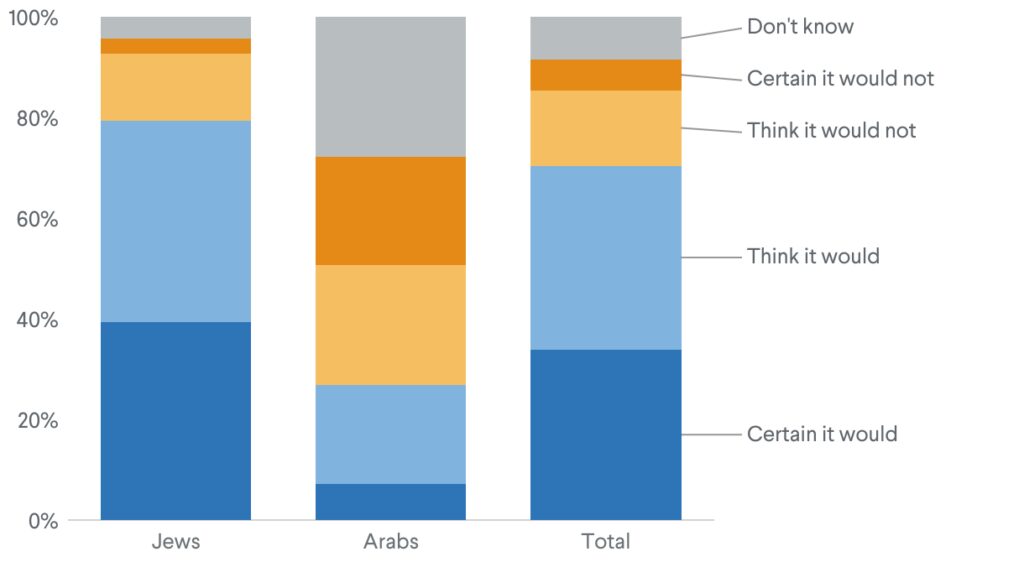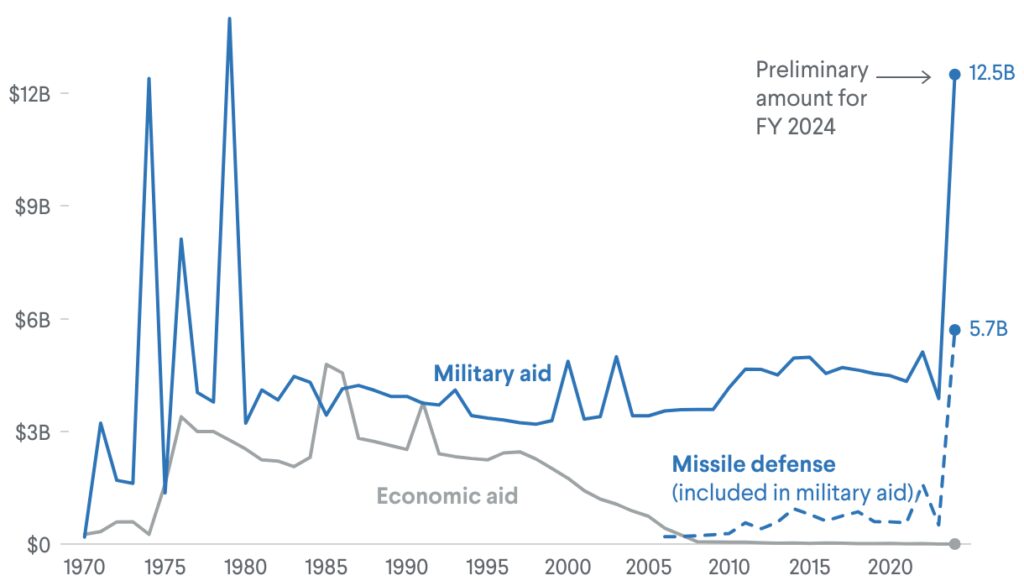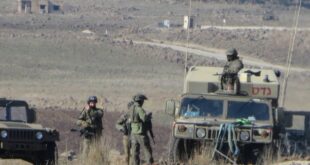One year after Hamas’s surprise attack on Israel, Elliott Abrams examines the extraordinary response of Israel’s government and society; Linda Robinson catalogues the wrenching toll on Palestinians in Gaza; Ray Takeyh surveys Iran’s newly challenged network of regional allies; and Steven Cook explores how much expanding conflict has tested U.S.-Israeli ties.
Israel’s Year of Trial and Reckoning on Defense
Most of 2023, which overlapped with the Jewish years 5783-4, was marked by deep internal divisions in Israel over “judicial reform”. Large demonstrations, vicious political rhetoric, and a sharp split between those who favored the reform as a way to limit excessive judicial power and those who saw it as the end of democracy in Israel heated Israeli politics to the boiling point.
But then came October 7, 2023, and the judicial reform was forgotten. The country came together in shock and horror at the magnitude of the loss of life and the brutality of the Hamas-led Palestinian armed groups who crossed the border from the Gaza Strip to kill, maim, rape, and take hostages. In the ensuing months of 2023, there was broad agreement on the need to defeat Hamas, and moreover, unified support for the soldiers of the Israeli Defense Forces. Some senior officers resigned quickly and others more slowly in the aftermath, taking responsibility for the security disaster, but the bravery and commitment of the young soldiers, most of them reservists, taught Israelis a lesson about their younger generation. There had been loose rhetoric by old-timers wondering whether the great generations who founded the state in 1948 and guided it through the wars of 1948, 1956, 1967, and 1973 were being followed by a new generation not up to the task of defending Israel. That argument is over.
But many other arguments are not. Whatever senior officers did in accepting blame, Prime Minister Benjamin Netanyahu accepted none himself. As the months passed, and the fighting wore on, he drew sharp criticism once again. On top of all his old issues, blame piled on for October 7 and for him not finding a way to get the hostages back. Here new divisions appeared: what should the price be to retrieve them before more died or were executed?
Displacement has also emerged as a major issue for the country. Some 75,000 Israelis have been forced from their homes in the north near the Lebanese border, by Hezbollah rockets and the fear of the kind of cross-border assault that came out of Gaza. Massive street demonstrations against the government were back even before the October 7 anniversary date, manifesting divisions over Netanyahu’s leadership and continuation in office, the conduct of the war, and the failure to get all the hostages back.
Meanwhile, the attacks on Israel from what Israelis call the “ring of fire”—referring to Iran and its proxies in Gaza, Iraq, Lebanon, and Syria—increased, and Iran attacked Israel directly in April and again in October. The Israeli political, intelligence, and military leadership had accepted for decades the “conception” (as it is now called by the press and public) that Hamas could be satisfied and deterred from a major assault on Israel if the group were allowed to govern Gaza. That is, Israel misplaced reliance on assumptions about Hamas’s beliefs and intentions. The spectacular failure of that approach led Israelis to look at Hezbollah and Iran differently—to look at capabilities, not assumed intentions. That is why Israel decided in September to change the rules of the game and respond with a powerful effort to reduce Hezbollah’s military capabilities. Within two weeks, that effort produced stunning results—killing Hezbollah’s leader, Hassan Nasrallah, and most of Hezbollah’s high command, as well as eliminating many of the launchers and missiles with which the organization had threatened Israel.
Security issues thus dominated this past year in Israel, which is no surprise. The “start-up nation” that was feeling increasingly safe in its neighborhood after the Abraham Accords were signed now sees many threats. Israelis now worry about the need for a larger army, which in turn means higher taxes, and their gratitude for the help of the United States is matched by the desire to manufacture more weapons at home and escape too much dependence on Washington.

It has been a difficult year and most Israelis expect more challenges to follow. They faced greater danger in the 1940s, 1960s, and 1970s, but now, as in those earlier times, the Jewish State knows it will have to fight for its future.
The Humanitarian Toll of the Israel-Hamas War on Palestinians
Linda Robinson is Senior Fellow for Women and Foreign Policy.
Since the horrific attack of October 7, 2023, by Hamas on Israel, the ensuing war between Israeli Defense Forces and Hamas militants has caused vast collateral damage that has completely devastated Palestinian lives and livelihoods. Hamas has compounded the suffering by hiding its forces, weaponry, and Israeli hostages in the densely packed urban terrain and tunnels of the Gaza Strip. As of September 2024, Palestinians in Gaza faced a grim tally of the carnage: at least 41,431 dead, 95,818 injured, and 1.9 million displaced out of the estimated 2.2 million population. The casualty figures supplied by the Hamas-run Gaza Ministry of Health, which are widely accepted by international monitoring organizations, do not include the large number of missing people. Only seventeen out of thirty-six hospitals were partially functioning, and much of Gaza’s buildings have been destroyed by heavy bombing that rivals the destruction of German cities in World War II. A satellite imagery survey in July 2024 estimated that 63 percent of Gaza’s buildings had been damaged, including 215,137 housing units. Life grew desperate a few months into Israel’s military campaign against Hamas forces as Israel closed border crossings into Gaza and Palestinians scrambled for food, water, medicine, money, and shelter, relying on aid packages that were slow to arrive. The UN Office of the Coordinator for Humanitarian Affairs reported in September that 46 percent of aid deliveries were impeded or denied outright to Palestinians in need.
As bombing and ground operations spread, 86 percent of Gaza was under mandatory evacuation orders by August, leaving al-Masawi, a sliver of sand already crowded with tents in the south, the only declared safe haven. The same month, the area was struck with a polio outbreak, twenty-five years after its eradication. Amid the worsening situation, with no cease-fire in sight, aid organizations revived earlier warnings of impending famine. The humanitarian organization Refugees International warned in September of increasing famine risk due to continued disruptions in aid delivery, bombing, and dislocations.
Palestinians living in the West Bank have also borne a heavy toll in the aftermath of Hamas’s October 7 attack, as Israeli forces locked down the enclave, stopped workers from traveling to jobs in Israel, and conducted increasingly extensive operations to find, detain, and kill suspected terrorists. More than seven hundred Palestinians in the West Bank and East Jerusalem have been killed since the war broke out, according to the Palestinian Authority Health Ministry in Ramallah. Since October 7, 2023, according to the UNOCHA report on September 25, 2024, Israeli authorities demolished 1,725 structures and displaced 4,450 Palestinians—double the rate of displacement in the preceding nearly one-year period. About one-third of Palestinians in the West Bank are unemployed, as businesses shuttered and permissions to travel and work in Israel were suspended after October 7.
Israel has also faced mounting concerns over the abuse and death of Palestinians detained since the start of the war, as footage has surfaced of various alleged atrocities. The United Nations reported that fifty-three Palestinians have died in custody since October 7, and the United States and the European Union have called for investigations into these reports as well as earlier reports of indiscriminate or deliberate targeting of civilians. The International Court of Justice ruled in May that Israel is obligated to protect civilians and meet basic needs, but the court lacks an enforcement mechanism absent UN action. Seven governments have begun to restrict assistance to Israel. In September, the United Kingdom suspended arms shipments to Israel out of concern about violations of international law. Under such laws, occupying powers may not deny aid to civilians.
Seeking to jar the world leaders gathering for the annual UN General Assembly on September 23, 2024, into action, the heads of the principal UN aid agencies summarized the situation in Gaza: “More than two million Palestinians are without protection, food, water, sanitation, shelter, health care, education, electricity, and fuel—the basic necessities to survive.” Pleading with the international community to secure an immediate cease-fire, the principals stated that “The parties’ [presumably Israel and Hamas] conduct over the last year makes a mockery of their claim to adhere to international humanitarian law and the minimum standards of humanity that it demands.”
Iran’s Axis of Resistance Holds On
Ray Takeyh is Hasib J. Sabbagh Senior Fellow for Middle East Studies.
A year after Hamas launched a devastating attack against Israel, the Islamic Republic, the group’s chief ally, faces a challenging regional landscape. In the past decade, the core of Iran’s foreign policy has been the so-called Axis of Resistance, a conglomeration of militias and terrorists that do Iran’s bidding in the Middle East from bases in Iraq, Lebanon, Syria, and Yemen. These proxies allow Iran to project power with a measure of immunity. So long as Iran is not directly involved in their acts of violence, it escapes accountability. Thus, Iran reaps the benefits but rarely pays a price.
Two of Iran’s most prized proxies are Hamas and Hezbollah and both have been heavily weakened by Israel since the Oct. 7 attacks. As a Sunni organization, Hamas allows Iran to present itself as the guardian of all Muslims. Hamas’s daring assault that managed to traumatize Israel has been much acclaimed by Iran. The clerical leaders surely anticipated a ferocious Israeli reaction but hoped that Hamas would survive in some form in the Gaza Strip. The Israeli retaliation has been aggressive and has done much to degrade the Palestinian militant group. Hamas could be on life support, but it is still alive. Iran hopes that as time goes by, the organization could revive itself, registering not just a blow against Israel but also remaining a keystone player in Palestinian politics.
Hezbollah is the most important Iranian proxy. The Shia militia was essentially created by Iran in the 1980 and has served as its spear for the past four decades. In the post 9/11 period, Hezbollah has been instrumental in training various Iranian proxies and coordinating their operations. After October 7, in solidarity with Hamas, Hezbollah launched attacks on Israel. Iran hoped that these strikes and the threat of a regional war would create international pressure on Israel to agree to a settlement that would permit Hamas to remain in Gaza. This has not happened, and as Israel turns its gaze north, another Iranian proxy is being degraded. Israel has decimated Hezbollah’s top leadership and even killed its leader, Hassan Nasrallah. The looming possibility of an Israeli land incursion means that Hezbollah could see itself evicted from portions of Lebanon. But the organization has not been destroyed, and it is still believed to have thousands of missiles in its arsenal, though diminished. The Iranians will do all they can to rebuild it, but for the foreseeable future Hezbollah is a diminished actor on the regional stage.
Iran is bracing for an Israeli military response, though both sides may seek to prevent a sharp escalation and a regional war. But military campaigns can have their own dynamic and, at times, propel national leaders into places they wish to avoid. This year has already seen the first ever Iranian attacks directly on Israel, with its assaults in April and October, though Israeli air defenses both times deflected the threat.
One of the unforeseen benefits for Iran of the past year’s conflict in the Middle East has been a greater isolation of Israel. Israel is now routinely censured in various international forums, particularly by nations of the Global South. In the meantime, Israel is becoming more of a wedge issue in American politics, pitting generations against each other. In a paradoxical move, Iran’s Supreme Leader Ali Khamenei who has done much to repress the country’s youth has emerged as the champion of protests on American college campuses. So long as war drags on in the Middle East, Western opinion is likely to further polarize, benefiting the Islamic Republic and Israel’s other enemies.
Growing Tensions in the ‘Special’ Relationship
Steven A. Cook is Eni Enrico Mattei Senior Fellow for Middle East and Africa Studies.
The contemporary U.S.-Israel relationship was forged during the John F. Kennedy administration. Upon meeting Israeli Foreign Minister Golda Meir in 1962, the president declared that the U.S. relationship with Israel was as “special” as that with the United Kingdom. Over the ensuing six decades, the United States has become committed to helping protect Israel, primarily through a defense relationship that requires Washington to ensure Israel’s “qualitative military edge” over its adversaries.

Yet as Kennedy implied, the relationship is not just about security. It is also bound up in history, politics, religion, and morality. It was the combination of these factors that prompted President Joe Biden to offer Israel important political, diplomatic, and military support after Hamas massacred as many as 1,200 Israelis—mostly civilians—in early October 2023. Paradoxically, that moment of maximum support sowed the seeds of tension between the Biden administration and the Israeli government.
The Israelis interpreted Biden’s demonstration of support—including a visit to Jerusalem eleven days after the attacks—as a signal that they had a green light from the United States to pursue Hamas as the Israel Defense Forces (IDF) saw fit. This disconnect has bedeviled the two countries over the ensuing months, though it is important to note that public disagreements obscure what has been unparalleled American support for Israel during its longest war. This is best exemplified by the air and sea bridge that the United States has established to ensure Israel a steady supply of military equipment and the U.S.-coordinated effort to defend Israel from Iranian missile and drone attacks in April 2024.
Throughout the first few months of the conflict, President Biden and his team did not seem overly concerned about Israel’s war plans. It was only after it became clear that large numbers of Palestinian civilians were being killed and that the president could pay a political price as a result of his support for Israel that the administration’s tone shifted (though not necessarily the administration’s policy). At the beginning of 2024, Biden’s acknowledgment of Palestinian suffering, his implicit criticism of Israel’s military operations, and the White House’s efforts to secure a cease-fire drove tension in the relationship. The Israeli government, Israel’s supporters, and some analysts argued that a cease-fire that did not require Hamas to surrender would benefit the designated terrorist organization.
The bilateral tension was further exacerbated when the IDF mistakenly killed seven workers from the World Central Kitchen, the U.S.-based non-governmental relief group, and as a result, the Biden administration placed heavy pressure on Israel to pause its operations. The White House then placed a hold on certain weapons—especially 2,000-pound bombs—ahead of Israel’s assault on Rafah in the southern Gaza Strip.
All of this tension was present as Israel began its effort to weaken Hezbollah in mid-September. After Israel’s pager and walkie-talkie attacks that injured or killed members of the terrorist group along with a much smaller group of civilians as well as an air strike that killed most of Hezbollah’s senior commanders, the United States and France called for a twenty-one-day cease-fire, fearing further escalation and a regional war. After apparently agreeing and then backing away, Israeli Prime Minister Benjamin Netanyahu and his security cabinet approved a strike on Hezbollah’s headquarters in southern Beirut that killed its secretary-general, Hassan Nasrallah. Israel’s unwillingness to sign onto the American and French plan put the U.S.-Israel relationship under further strain. The fact that Israel no longer seems to be taking American advice has not altered the Biden administration’s approach to helping ensure Israeli security, however. Despite its concerns about a regional war, the United States indicated its support for a limited Israeli ground campaign in southern Lebanon that began on September 30, and it helped Israel deter a ballistic missile attack from Iran on October 1, the second such attack this year.
It remains an open question whether the Israel-Hamas war will result in lasting damage to the U.S.-Israel relationship. Whereas Republican support for Israel remains robust, there has been a discernible shift among Democrats who are now split on the special relationship. One of the changes that could arise from the crisis that has enveloped the Middle East over the last year is an acceleration of a new dynamic between the United States and Israel that loosens the alleged unbreakable bonds between the two countries.
 Eurasia Press & News
Eurasia Press & News


